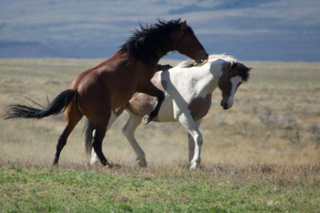 |
| Davis Mountains, Utah |
After a short adieu, we left Utah. We traveled across Nevada then turned north into Oregon. A friend suggested we visit the Steens Mountains wild horse herd. Unfortunately with 89 inches of snow still needing to melt, the wild horse loop was closed. We did, however, find a BLM brochure on the Kiger mustang herd and decided to try to locate them the following morning.
The road was rugged and wet... definitely one best traveled in a vehicle with high clearance. It took us nearly an hour to travel eleven miles to the viewing area.
We finally found the viewing lot. The scenery was beautiful... but no horses. Finally, as if to appease us, a lone horse walked into the valley below us, out from among the junipers. We watched for a while, hoping others would join him. Unfortunately, no. We needed to get back on the road to visit our friends in Washington, so we made the trek back towards Burns.
Kiger mustang signpost
 |
| Steen Mountains |
 |
| Lone Kiger mustang |
This past year's journey through wild horse country has been more than just a little surprising... and a great education. Originally we had just wanted to visit as many wild horse herds as we could. We never expected to encounter the emotionally-charged controversy surrounding these amazing creatures. Over the past year, we have learned much. We have spoken with many members of wild horse advocacy groups, some cooperative and others hostile to the BLM. We had only spoken with one BLM official.
As we've reported, much of the controversy lies with the 45,000 once wild horses now living in corrals managed by the BLM. We had heard horror stories ranging from overcrowding to malnutrition to outright abuse. We felt that in order to get a full view of both sides of the issue we should try to see the BLM's perspective and visit at least one of their corrals.
We didn't know what to expect when we went to the BLM office and asked if we could see the corrals. To our surprise, not only were we allowed on the premises, the facility's personnel welcomed us. They even had an auto tour around the corrals for the public to view the horses and how they are kept.
Quite honestly, it is an amazing facility. The over 500 horses living there were segregated into logical corrals: mares with foals, weanlings with yearlings, and, of course, corrals for geldings. There was no overcrowding, and the horses were obviously calm and well fed. Most importantly, each corral was immaculately clean... a telltale sign of good care to anyone with ranching experience.
 |
| Mare and foal corral in foreground |
 |
| Gelding pen |
 |
| Plenty of fresh hay |
 |
| New hay barn |
Is the Hines wild horse corral facility simply a model while other BLM holding corrals pale in comparison? If so, it is a very good model, indeed. While some other BLM facilities may have diminished adoption rates, the Hines facility does not. They promote their horses for adoption. I was tremendously impressed.
We leave the wild horses for this leg of our trip and turn our sights now to Alaska. We know full well that the controversy surrounding these amazing animals will continue. We are buoyed, however, by the fact that we have met so many who are passionate about saving these symbols of the west... both in advocacy groups and BLM personnel. We also know that there are things each of us can do to help. (For more information, see our September 20, 2016 post What you can do to help.)
Tonight we are in Sammamish, Washington, visiting dear friends. I am happy to report that the camera appears to be functioning well again. As suspected, it was an operator error. Thankfully, last night one of our RMOWP (rmowp.org) friends was able to walk me through the fix over the phone... thanks, Al!







No comments:
Post a Comment